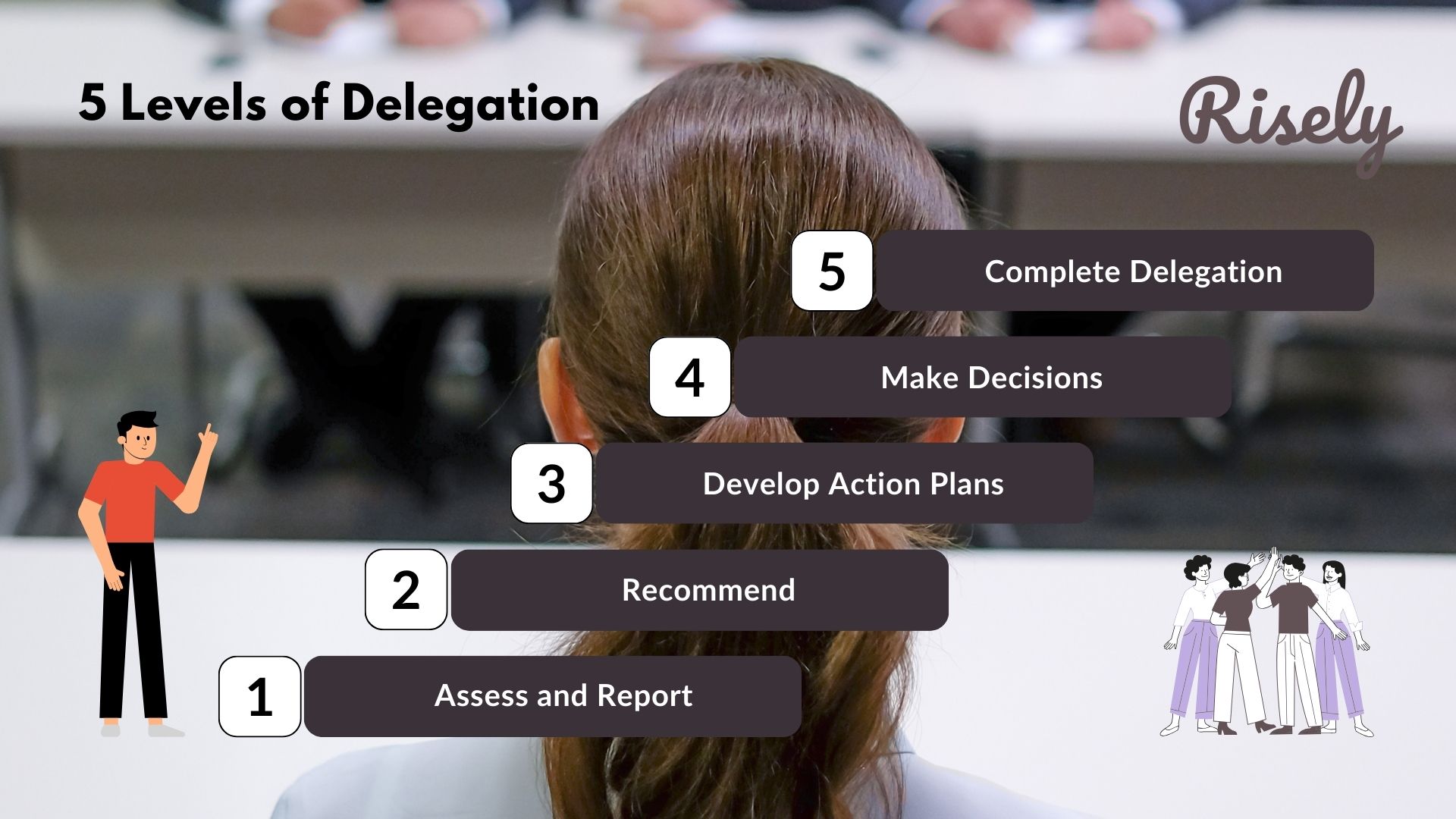Mastering 5 Levels of Delegation: The Key to Managerial Success
Picture this: your to-do list is a monstrous beast, overflowing with tasks and threatening to topple you over. You know you can’t tackle it all alone, but the thought of delegating feels like adding another burden to your plate. What if delegation wasn’t a chore, but a strategic secret weapon? Here’s the truth: effective delegation isn’t just about dumping work on someone else. It’s about empowering your team, boosting their morale, and ultimately, achieving more together. But how do you delegate effectively? The key lies in understanding the different levels and styles of delegation. In this blog, we’ll break down the five levels of delegation, a framework that will transform you from a swamped taskmaster to a delegation master. We’ll also explore common delegation styles, helping you choose the right approach for every situation. So, ditch the overwhelm and get ready to unlock the power of delegation! Let’s dive in!What is Effective Delegation in the Workplace?
Effective delegation of power can differentiate between a successful and a failing organization. A manager delegates tasks and responsibilities to subordinates, who then perform the tasks with efficiency and effectiveness. Having delegated authority in your workplace can help you build strong relationships between employees and managers and foster teamwork. Following the principles of delegation and inculcating the essential delegation skills is to key to getting it right. Otherwise, there are many problems that can affect the quality of delegated tasks.What are the Five Levels of Delegation?
Delegation of power is the act of giving authority and responsibility to another person. It is an important management skill but can also be challenging. Therefore, it is essential to understand the levels of delegation and the various ways of delegating power.Level 1: Assess and Report
The initial levels of delegation give the employee the power to understand and assess the situation perfectly. They are permitted to collect information about the scenarios the team is dealing with. However, they cannot play an active role in decision-making. Their inputs are taken by the managers for preparing reports but may not be treated as recommendations. In this level of delegation, the manager is always aware of what is happening and checks in with their subordinates regularly. They provide feedback and guidance but need to be more hands-on with the work being done. The only con with this level of delegation is that the employee may feel that their efforts are not valued adequately if they cannot see them impacting the results in any manner whatsoever. Hence, feedback from managers remains critical at this stage. For example: In a software development project, a manager delegates the task of assessing the current status of a specific module to a software engineer. The engineer’s responsibility is to gather data, identify issues, and report on the module’s performance. However, the engineer does not have the authority to make decisions or changes to the module; their role is limited to data collection and reporting. The manager remains closely involved and provides guidance on what information to gather.Level 2: Recommend
At the second level of delegation, the manager passes on some of the decision-making authority to their employee. The subordinate is now permitted to make recommendations but must still follow instructions from their managers if they want their recommendations accepted. This level of delegation is beneficial as it enhances creativity and productivity while increasing team member ownership. It also enables employees to take charge when faced with challenging situations or new challenges that they have not encountered before. The decision-making authority, however, still rests with the manager only. For example: The manager allows the software engineer to assess the module and recommend improvements. The engineer can suggest changes based on their assessment, such as optimizing code or implementing new features. However, the final decision on implementing these recommendations still rests with the manager. The manager values the engineer’s input but has the ultimate authority to approve or reject the proposed changes.
Level 3: Develop Action Plans
The third level of delegation takes authority a step further. Here, the employee can develop action plans and take specific steps toward achieving the team’s goal with prior approval from their managers. In some cases, this may even extend to making decisions within the guidelines their superiors have set. A manager continues to supervise minutely here. This level of delegation is beneficial as it allows employees to feel more ownership of their work and provides them with strong strategic planning skills, which are often lacking in novice employees. It also helps build trust between manager and employee, as each party can measure the other’s performance. However, this level of delegation can also be challenging to manage as it can lead to employees taking on too much responsibility and becoming overzealous in their attempts to achieve results. For example: In this level, the manager delegates the responsibility for assessing the module and developing action plans to address any issues. The software engineer makes recommendations and creates a detailed plan outlining how to improve the module. This plan includes timelines, resource allocation, and specific steps for implementation. However, the manager must review and approve the action plan before the engineer proceeds with execution. The manager remains closely involved in planning to ensure alignment with overall project goals.Level 4: Make Decisions
The later levels of delegation are the ultimate goal of most organizations. Employees can make decisions independently with full authority and responsibility for the outcomes. In some cases, this may even extend to making changes or taking new initiatives not previously discussed or approved by their managers. This level of delegation can be a challenge for both manager and employee as it requires a high degree of trust and communication between the two parties. It also requires a clear vision and roadmap toward success which can often be challenging to develop in an environment where change is constantly occurring. Without features that make delegation easier, the manager might end up micromanaging their team. Hence, ensuring that you allow the employee to develop substantial task ownership is critical. For example: In the same software development project, the manager takes delegation further by allowing the software engineer to make real-time decisions about the module’s development. The engineer can adjust the coding approach, make design choices, and allocate tasks to other team members as needed to meet project goals. While the manager is available for guidance and consultation, they trust the engineer to make these decisions independently. The engineer can even propose changes to the project plan without seeking prior approval, but the manager retains the final authority.Level 5: Complete Delegation
L5 is the ultimate delegation level and should only be given to employees who have proven their ability to handle full responsibility for their work. These employees should also be able to communicate effectively with their managers, ensuring that all aspects of the project are clearly understood. For L5 delegation to be successful, both manager and employee must share a common vision for the project and a clear understanding of team goals and objectives. It can also be helpful if managers provide clear feedback on progress so that the delegating employee can improve upon any deficiencies they may find. Even though the approach sounds like complete independence, the manager remains in touch and offers guidance and supervision as needed. The manager retains the final authority and responsibility regarding the task. For example: At the highest level of delegation, the manager fully entrusts the software engineer with the responsibility for the entire module. The engineer has the autonomy to define the module’s architecture, allocate resources, and make all decisions related to its development without constant oversight. While the manager is still available for support and guidance, they do not interfere in day-to-day decisions. The engineer fully owns the module and is accountable for its success. However, the manager retains ultimate responsibility for the project’s overall success and can step in if necessary. Through these five levels of delegation, we can then move on to understand the types of delegation we can find in workplaces around us. For example, managers may only sometimes stick to a particular level but collaborate on the features of multiple levels of delegation to create the system best suitable for their team.Other Interesting Reads
Advantages of Mastering Delegation
Delegation isn’t just a fancy management term; it’s a superpower that separates good managers from great ones. By mastering this art, you’ll lighten your load and cultivate a thriving, productive team. Here’s why delegation deserves a permanent spot in your leadership toolkit:- A Symphony of Benefits: Imagine your team as a well-oiled orchestra. Each member brings a unique talent, but the conductor harmonizes them into a beautiful performance. Effective delegation works the same way. Here are the instruments that play a sweet melody in your favor:
- Boosted Productivity: Delegating frees you from micromanaging and allows you to focus on strategic initiatives. Empowered team members, meanwhile, take ownership and often find more efficient ways to complete tasks.
- Employee Growth & Development: Assigning challenging tasks stretches your team’s skills and fosters a sense of accomplishment. This benefits individual growth and creates a valuable talent pool within your team.
- Improved Morale & Engagement: Feeling trusted and valued is a morale booster. Delegation shows your team you believe in their abilities, leading to increased engagement and a more positive work environment.
- Enhanced Problem-Solving: Diverse perspectives breed innovative solutions. By delegating, you tap into your team’s collective brainpower, leading to more creative approaches to challenges.
- Stronger Leadership: Delegation showcases your ability to trust, empower, and develop your team. This fosters respect and strengthens your leadership image.
- Sharper Focus: By delegating routine tasks, you free up mental space to focus on strategic planning and big-picture thinking, which allows you to steer your team toward long-term goals.
- Succession Planning: Delegation identifies and nurtures talent within your team. By providing opportunities to take ownership, you cultivate future leaders who can seamlessly step up when needed.
What are the Basic Delegation Types for Every Manager?
Now that we understand the various levels of delegation. We can move forward with the common delegation types that are used by managers in the workplace. Delegation is an essential part of every manager’s job. Understanding the different types of delegation of power and the benefits of each kind of delegation is vital to becoming a better manager.Delegation of authority
Delegation of authority means handing over power and decision-making to someone else to free up the manager’s time. This type of delegation can be effective when a manager needs to focus on other tasks or doesn’t have the necessary skills or knowledge to take on a project themselves. While delegating authority, managers need to ensure that a few essential requirements are met:- Goals and outcomes leading to them are clearly defined
- The employee should have clarity on their role and responsibility
- Accountability is essential in the process
Delegation of responsibility
Delegation of responsibility means entrusting an employee with completing a specific task or project. In this type of delegation, the manager retains overall control and authority to ensure the goal is met. When delegating responsibilities, ensure that your employees are prepared with the hard and soft skills to do justice to the role.Complete or Partial Delegation
Managers may either fully delegate the responsibility or only partially delegate it when they delegate a task or project. When delegating partially, managers must remember that delegation is never 100% complete and should be checked regularly. Partial delegation allows employees more ownership of their work and can increase team productivity. However, it can also confuse if the manager does not ensure clarity. Different levels of delegation can work well depending on the situation and team. For example, if an employee lacks the specific knowledge required for a task but has the skills needed for some parts of the task, the partial delegation could be effective.General or Specific Delegation
General delegation is the most common type of delegation and involves delegating a task or project to an employee without specifying the level of detail or specifics. This type of delegation allows employees more freedom to get started with the task, but it can also lead to confusion. Employees may be delegated tasks under the whole department in the general delegation. On the other hand, the specific delegation specifies the detail that needs to be included for an employee to complete the task correctly. As a result, employees have more important details of their responsibilities.Formal or Informal Delegation
The delegation that is carried out within the set structure of the organization is termed a formal delegation. The responsibilities are clearly defined as per the precedent. The employees, in general, are aware of the expectations held towards them by the managers. They are also formally obliged to carry out the task and ensure outcomes. On the other hand, informal delegation may happen at the behest of circumstances. For example, an employee can take up additional duties in their manager’s absence or assist their manager as a deadline is fast approaching. Often, as it lacks a formal contract, the obligation is optional but a function of the norms governing workplace behavior.Conclusion
Delegation isn’t a one-time trick you pull out of your hat; it’s a skill to be honed over time. By understanding the different delegation levels and styles, and by carefully matching tasks to your team members’ strengths, you’ll transform from a swamped taskmaster into a delegation maestro! Don’t just delegate tasks, delegate ownership! By understanding the delegation levels and styles, you’ll become an orchestra conductor, not just a taskmaster. You’ll weave a symphony of strengths from your team members, and the music will be their success – and yours. So, ditch the soloist mentality and embrace the power of collaboration. Watch your team transform into a high-performing ensemble, where every member plays a vital role in creating beautiful results. Now go forth and conduct your team to greatness!Are your delegation skills effective?
Test now with the free Effective Delegation self-assessment to discover your blind spots.
Other Related Blogs
A Decade in Making: Decoding Shyam Gor’s Managerial Approach
A Decade in Making: Decoding Shyam Gor’s Managerial Approach “People don’t leave companies, they leave managers.” We have all heard this adage over the years. Shyam Gor is a manager…
Grooming for Management: The Key to Building a Sustainable Leadership Pipeline
Grooming for Management: The Key to Building a Sustainable Leadership Pipeline Imagine a crucial leadership position opening up in your organization. You scramble to fill the role, internally and externally,…
Looking For a Delegation Coach? 10 Delegation Training Courses at Your Fingertips for quick learning
Looking For a Delegation Coach? 10 Delegation Training Courses at Your Fingertips for quick learning Delegation is a cornerstone skill for any manager or leader aiming to foster team growth…
5 Impactful Leadership Coaching Styles For Your Team
5 Impactful Leadership Coaching Styles For Your Team Have you ever wondered what sets great leaders apart from the rest? It’s about more than just authority or expertise but their…


